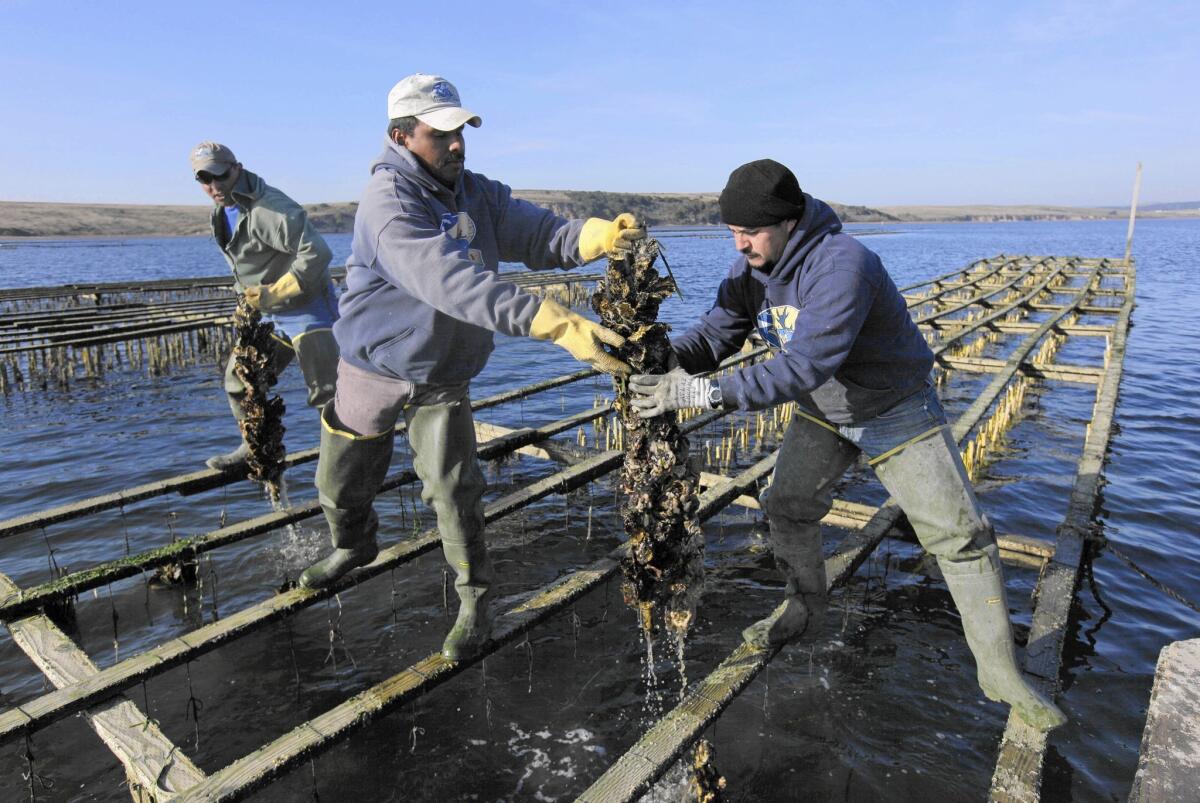West Coast fisheries are at risk as climate change disturbs the ocean’s chemistry

- Share via
The West Coast’s abundant fisheries are at risk as the region’s waters become more acidic, a group of scientists warn.
Researchers from the West Coast Ocean Acidification and Hypoxia Science Panel released a report this month that projects dire changes to ocean chemistry and marine life, and recommends ways to avert it, including restoring kelp forests and eelgrass beds and combating marine pollution.
The panel convened in 2013 to study how global carbon emissions are lowering pH and reducing oxygen levels in the ocean off the West Coast.
“Although ocean acidification is a global phenomenon, emerging research indicates that the U.S.-Canadian West Coast will face some of the earliest, most severe changes in ocean carbon chemistry,” the report says.
Because of the way the Pacific Ocean circulates, the West Coast is exposed to more acidic water than other areas of the globe. Oyster production in the Pacific Northwest has already declined, as changes in ocean chemistry tamper with shell formation, and scientists warn that popular game fish and other species are also at risk.
“For some organisms, and perhaps ultimately for some ecosystems, high carbon dioxide levels where they had not previously been expected could be a problem,” said Andrew Dickson, a professor of marine chemistry at Scripps Institution of Oceanography and a member of the panel.
Disturbance of ocean chemistry is the lesser known twin to the atmospheric warming and weather changes wrought by climate change. About a third of the carbon released by humans is absorbed by the ocean, according to the report. That keeps some of the excess carbon out of the air but creates its own problems when carbon dioxide reacts with water. Together, they form a weak acid that sours the sea.
Overall, ocean water has dropped by about 0.1 pH unit, from about 8.2 to 8.1 pH, the report states. It seems like a small change, but because pH values are logarithmic, it represents a 30% increase in acidity.
See more of our top stories on Facebook >>
Oyster production in the Pacific Northwest dropped 22% between 2005 and 2009, the report says, and major oyster hatcheries saw production crash.
The increased acidity damages small, floating snails called pteropods — or sea butterflies — that are a key food source for fish including herring, mackerel and salmon.
“Scientists on the West Coast, when they collected these sea butterflies in the wild, they could actually see that their shells are starting to corrode,” said ecologist Francis Chan, the panel’s co-chair and a professor of integrative biology at Oregon State University.
The increased acidity can also disrupt reproduction, neurology and behavior of other sea life.
As carbon dioxide levels in the ocean rise, dissolved oxygen decreases, researchers said, posing a separate but related problem for marine life.
“There are episodes where we’re seeing low oxygen closer to shore than we think is normal,” Chan said. “Quite simply, things can’t breathe and they suffocate.”
Starting in 2006, “dead zones” of low oxygen in shallow waters off the Pacific Northwest led to mass die-offs of Dungeness crabs and other animals.
Gretchen Hofmann, a panel member and biology professor at UC Santa Barbara, is studying whether combined effects of ocean acidification and low oxygen could disrupt egg production of popular sport fish such as rockfish and cabezon.
The impacts on fisheries could cripple the region’s seafood supply. Market squid, sea urchin, chinook salmon, rockfish and Dungeness crab are all species threatened by changes to ocean chemistry.
The disturbance is particularly troublesome for California and other parts of the West Coast because of upwelling currents that heave deep, cold, biologically rich waters toward shore.
“This upwelling is both a blessing and a curse,” Chan said. “The upwelling injects nutrients that make our ocean so productive. That’s why Steinbeck wrote ‘Cannery Row.’ We live in a very special ocean. But the curse is that this upwelling creates low oxygen and low pH. So we’re much closer to any tipping points that could push us past a threshold.”
Although the causes and effects of ocean acidification and low oxygen are global, the panel found hopeful news about the potential to deal with it locally.
Seagrass beds and kelp forests are more productive than tropical forests, capturing more carbon than other systems on the planet. By restoring marine vegetation, scientists hope to raise pH and oxygen levels in key areas.
Curbing marine pollution can also improve ocean chemistry, scientists said. Runoff from farms and lawns, such as nitrogen and phosphorus, feed algal blooms that dump carbon and deplete oxygen from local waters. Cutting back on those pollutants can “put off a potential evil hour when carbon dioxide” levels are so high that they cause irreparable damage to marine life, Dickson said.
Efforts to battle ocean acidification and low oxygen on the West Coast will be test cases for dealing with the problem elsewhere, scientists said.
“The West Coast will be a harbinger for the types of ocean acidification impacts that will be widely felt across coastal North America in the coming decades,” the report states.
Despite the gloomy news, Chan said he’s hopeful that a solution is at hand, noting that bills pending in the California Legislature — AB 2139 and SB 1363 — would study ocean acidity and promote eelgrass restoration.
“I’m leaving with an optimistic note, which I tend not to as a scientist,” he said, “but I think the people who make decisions get it and are ready to do something.”
Sullivan Brennan writes for the San Diego Union-Tribune.
ALSO
Could mysterious gamma-ray burst be linked to gravitational wave find?
Feeling rejected? Mushrooms could help
Dinosaurs were in decline long before the Chicxulub asteroid finished them off



